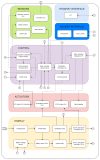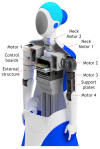Qhali: A Humanoid Robot for Assisting in Mental Health Treatment
- PMID: 38400478
- PMCID: PMC10891936
- DOI: 10.3390/s24041321
Qhali: A Humanoid Robot for Assisting in Mental Health Treatment
Abstract
In recent years, social assistive robots have gained significant acceptance in healthcare settings, particularly for tasks such as patient care and monitoring. This paper offers a comprehensive overview of the expressive humanoid robot, Qhali, with a focus on its industrial design, essential components, and validation in a controlled environment. The industrial design phase encompasses research, ideation, design, manufacturing, and implementation. Subsequently, the mechatronic system is detailed, covering sensing, actuation, control, energy, and software interface. Qhali's capabilities include autonomous execution of routines for mental health promotion and psychological testing. The software platform enables therapist-directed interventions, allowing the robot to convey emotional gestures through joint and head movements and simulate various facial expressions for more engaging interactions. Finally, with the robot fully operational, an initial behavioral experiment was conducted to validate Qhali's capability to deliver telepsychological interventions. The findings from this preliminary study indicate that participants reported enhancements in their emotional well-being, along with positive outcomes in their perception of the psychological intervention conducted with the humanoid robot.
Keywords: humanoid robotics; mental health; social assistive robot.
Conflict of interest statement
The authors declare no conflicts of interest.
Figures



















References
-
- Stasse O., Flayols T. An Overview of Humanoid Robots Technologies. In: Venture G., Laumond J.-P., Watier B., editors. Biomechanics of Anthropomorphic Systems. Volume 124. Springer International Publishing; Cham, Switzerland: 2019. pp. 281–310. - DOI
-
- Yoshida E. Robots that look like humans: A brief look into humanoid robotics. Metode. 2018;9:143–151. doi: 10.7203/metode.9.11405. - DOI
-
- Feil-Seifer D., Mataric M.J. Socially Assistive Robotics; Proceedings of the 9th International Conference on Rehabilitation Robotics, ICORR 2005; Chicago, IL, USA. 28 June–1 July 2005; pp. 465–468. - DOI
-
- Meghdari A., Alemi M., Khamooshi M., Amoozandeh A., Shariati A., Mozafari B. Conceptual design of a social robot for pediatric hospitals; Proceedings of the 2016 4th International Conference on Robotics and Mechatronics (ICROM); Tehran, Iran. 26–28 October 2016; pp. 566–571. - DOI
-
- Afaq A., Gaur L. The Rise of Robots to Help Combat COVID-19; Proceedings of the 2021 International Conference on Technological Advancements and Innovations (ICTAI); Tashkent, Uzbekistan. 10–12 November 2021; pp. 69–74. - DOI
Publication types
MeSH terms
Grants and funding
LinkOut - more resources
Full Text Sources

